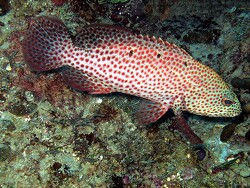Info
(Lacepède, 1802)
Cephalopholis cruentata in the English language this fish is also called „Graysby“, found widespread in the Caribbean and the Gulf of Mexico, north to the "Carolina's" (USA) and south to the coast of Brazil.
The body color varies from light brown to reddish-brown-beige tones, often with striking dark red spots over the entire body. A striking detection feature are 3-5 dark, usually black or brown blotches or spots along the base of the dorsal fin, at night, these spots often almost white. Gender differences are not known, at least visually. Juvenile animals are usually darker colored and have usually an easily recognizable bright, almost white line on or around the mouth.
With 40 cm in length quite a fish for an aquarium, but less interesting when you know that these animals are nocturnal hunters and often spend the day resting in the reef in columns or sponges. One finds them both in reefs and in lagoons as well as "Drop-Off's" ,juvenile usually at greater depths.
Like all groupers also the "Graysby" is a Carnivore, so he hunts and eats as good as everything which fits in its mouth, whether fish, crab, shrimp, squids or worms. Enemies of the "Graysby" includ, for example, barracuda,s and of course sharks.
Synonyms:
Bodianus stellatus Blosser, 1909
Cephalopholis cruentatus (Lacepède, 1802)
Epinephelus cruentatus (Lacepède, 1802)
Petrometopon cruentatum (Lacepède, 1802)
Petrometopon cruentatus (Lacepède, 1802)
Serranus apiarius Poey, 1860
Serranus coronatus Valenciennes, 1828
Serranus nigriculus Valenciennes, 1828
Sparus cruentatus Lacepède, 1802
Classification: Biota > Animalia (Kingdom) > Chordata (Phylum) > Vertebrata (Subphylum) > Gnathostomata (Superclass) > Pisces (Superclass) > Actinopteri (Class) > Perciformes (Order) > Percoidei (Suborder) > Serranidae (Family) > Epinephelinae (Subfamily) > Cephalopholis (Genus) > Cephalopholis cruentata (Species)
hma
Cephalopholis cruentata in the English language this fish is also called „Graysby“, found widespread in the Caribbean and the Gulf of Mexico, north to the "Carolina's" (USA) and south to the coast of Brazil.
The body color varies from light brown to reddish-brown-beige tones, often with striking dark red spots over the entire body. A striking detection feature are 3-5 dark, usually black or brown blotches or spots along the base of the dorsal fin, at night, these spots often almost white. Gender differences are not known, at least visually. Juvenile animals are usually darker colored and have usually an easily recognizable bright, almost white line on or around the mouth.
With 40 cm in length quite a fish for an aquarium, but less interesting when you know that these animals are nocturnal hunters and often spend the day resting in the reef in columns or sponges. One finds them both in reefs and in lagoons as well as "Drop-Off's" ,juvenile usually at greater depths.
Like all groupers also the "Graysby" is a Carnivore, so he hunts and eats as good as everything which fits in its mouth, whether fish, crab, shrimp, squids or worms. Enemies of the "Graysby" includ, for example, barracuda,s and of course sharks.
Synonyms:
Bodianus stellatus Blosser, 1909
Cephalopholis cruentatus (Lacepède, 1802)
Epinephelus cruentatus (Lacepède, 1802)
Petrometopon cruentatum (Lacepède, 1802)
Petrometopon cruentatus (Lacepède, 1802)
Serranus apiarius Poey, 1860
Serranus coronatus Valenciennes, 1828
Serranus nigriculus Valenciennes, 1828
Sparus cruentatus Lacepède, 1802
Classification: Biota > Animalia (Kingdom) > Chordata (Phylum) > Vertebrata (Subphylum) > Gnathostomata (Superclass) > Pisces (Superclass) > Actinopteri (Class) > Perciformes (Order) > Percoidei (Suborder) > Serranidae (Family) > Epinephelinae (Subfamily) > Cephalopholis (Genus) > Cephalopholis cruentata (Species)
hma







 François Libert, Frankreich
François Libert, Frankreich





































